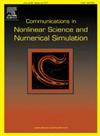Subspace method based on neural networks for solving the partial differential equation in weak form
IF 3.8
2区 数学
Q1 MATHEMATICS, APPLIED
Communications in Nonlinear Science and Numerical Simulation
Pub Date : 2025-09-28
DOI:10.1016/j.cnsns.2025.109367
引用次数: 0
Abstract
In this paper, we propose a subspace method based on neural networks for solving the partial differential equations (PDEs) in weak form. The method uses neural network-based functions as basis functions to span a subspace, within which an approximate solution is sought. The related algorithms are developed to address both linear and nonlinear PDEs with various boundary conditions in weak form. To improve the approximation capabilities of the subspace, multiple training strategies are employed. Numerical experiments demonstrate that the proposed method achieves high accuracy with minimal computational cost, requiring only 100 to 2,000 training epochs in most cases. The method offers significant advantages in both accuracy and computational efficiency. The codes and data associated with this work are openly available at基于神经网络的子空间法求解弱形式偏微分方程
本文提出了一种基于神经网络的求解弱形式偏微分方程的子空间方法。该方法使用基于神经网络的函数作为基函数来跨出子空间,在子空间内寻找近似解。针对具有各种弱形式边界条件的线性偏微分方程和非线性偏微分方程,提出了相应的算法。为了提高子空间的逼近能力,采用了多种训练策略。数值实验表明,该方法在大多数情况下只需要100 ~ 2000次训练,以最小的计算代价获得了较高的精度。该方法在精度和计算效率方面具有显著的优势。与这项工作相关的代码和数据可在https://github.com/CM-1-NEW/SNNW上公开获取。
本文章由计算机程序翻译,如有差异,请以英文原文为准。
求助全文
约1分钟内获得全文
求助全文
来源期刊

Communications in Nonlinear Science and Numerical Simulation
MATHEMATICS, APPLIED-MATHEMATICS, INTERDISCIPLINARY APPLICATIONS
CiteScore
6.80
自引率
7.70%
发文量
378
审稿时长
78 days
期刊介绍:
The journal publishes original research findings on experimental observation, mathematical modeling, theoretical analysis and numerical simulation, for more accurate description, better prediction or novel application, of nonlinear phenomena in science and engineering. It offers a venue for researchers to make rapid exchange of ideas and techniques in nonlinear science and complexity.
The submission of manuscripts with cross-disciplinary approaches in nonlinear science and complexity is particularly encouraged.
Topics of interest:
Nonlinear differential or delay equations, Lie group analysis and asymptotic methods, Discontinuous systems, Fractals, Fractional calculus and dynamics, Nonlinear effects in quantum mechanics, Nonlinear stochastic processes, Experimental nonlinear science, Time-series and signal analysis, Computational methods and simulations in nonlinear science and engineering, Control of dynamical systems, Synchronization, Lyapunov analysis, High-dimensional chaos and turbulence, Chaos in Hamiltonian systems, Integrable systems and solitons, Collective behavior in many-body systems, Biological physics and networks, Nonlinear mechanical systems, Complex systems and complexity.
No length limitation for contributions is set, but only concisely written manuscripts are published. Brief papers are published on the basis of Rapid Communications. Discussions of previously published papers are welcome.
 求助内容:
求助内容: 应助结果提醒方式:
应助结果提醒方式:


